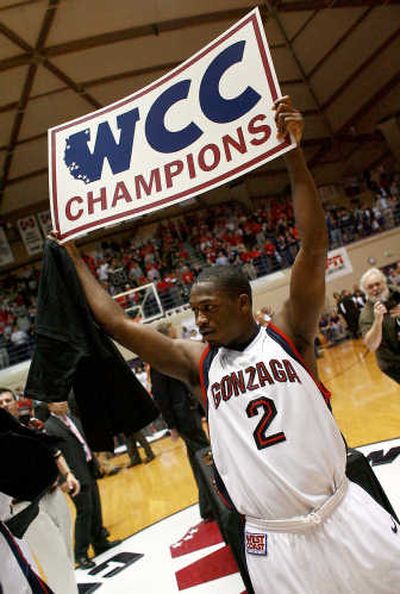Be nice if GU wasn’t in league of own

Has Gonzaga become hazardous to the health of the West Coast Conference?
Hey, someone had to ask.
This is not likely to be a popular notion in the Zag basketball hive, where finishing atop the WCC standings has come to be regarded as a birthright – and even an afterthought among the more full-of-themselves constituents. Happily, this is not the case among the Bulldogs themselves.
“I’m sure it probably gets old to everyone else in the league,” acknowledged senior David Pendergraft. “I don’t even know how many years it is now. But we don’t get sick of it, and in fact our goal is to go undefeated.”
That’s not hubris. The Zags have run the conference table twice in four years, not exactly an endorsement of the WCC’s brand of siccum. Elsewhere in the Division I lodge, only Penn has managed the feat twice in the 2000s. Now, the WCC may like to think of itself as the Ivy League of the West, but not in that particular context.
Now the 56th season of WCC basketball begins tonight with the Zags in search of their eighth straight regular-season title.
But frankly, somebody else needs to win this league.
We’re not talking about the conference tournament and the automatic bid to the NCAA tournament that goes with it. That bit of spectacle deserves all the drama and excitement Gonzaga can add, win or lose.
Over the next eight weeks, however, the WCC could use a makeover, not that the Zags should be expected to cooperate.
And what do you know – a likely candidate has emerged.
Saint Mary’s – with a talented junior-rich lineup, an instant star in Australian guard Patrick Mills and a well-crafted schedule – has twice chinned itself up into the Top 25, although Southern Illinois and Texas came along each time to pull the Gaels back down. Even Gonzaga coach Mark Few offered that “they’re ahead of where we are right now,” though of course the Bulldogs are still the bull’s-eye.
Whether the Gaels get it done or not, they have at least managed to change the tenor of the conversation.
“It’s good for the league,” Few said of the Gaels’ early surge. “The more good teams we have that get some national attention, it improves our perception – which hopefully can lead to multiple bids out of this league. It helps to educate people. There has always been some really good basketball teams in this league and we’ve not always gotten credit for that.”
Well, the fact is, there have been some teams during the time of Gonzaga’s dominion over the league that play well against the Zags, but not often enough against anybody else. Yes, Pepperdine and Saint Mary’s have managed at-large bids to the NCAA tournament, but GU has also won the WCC by three, five and six games other years.
Good for the Zags, bad for public relations.
In the last 15 years, there has not been a longer streak in Division I basketball than Gonzaga’s current run of seven outright or shared regular-season titles – and only four longer ones in history in conferences that still exist (see accompanying chart). And in each case, the effects were debilitating.
It took nearly two decades, until Arizona won a national championship in 1997, before the notion that Pac-10 basketball was UCLA and nine spear-carriers ebbed. Likewise, Kentucky was the one basketball school in a football conference for a huge hunk of SEC history. The Big West was Jerry Tarkanian’s toybox and hasn’t been heard from since his departure.
In none of those instances did the top dog’s excellence pull up the rest of the conference, and neither has Gonzaga – which, of course, cannot be the Zags’ responsibility.
The mid-major label assigned to those below the big six BCS leagues is imprecise, but the WCC comes off as more mid than major – and that’s seen in the extra bids to the NCAAs accorded those conferences. The Missouri Valley, for instance, has had 13 teams in the bracket over the last five years. the Mountain West and Atlantic-10 have had 12 apiece. Conference USA has had 17, though most of those were before Marquette, Louisville, Cincinnati and others fled.
The WCC has had seven in that same span. It is, mostly, a one-bid league – and remains so because a few of its teams flounder near the bottom of the Ratings Percentage Index year after year, pulling down the at-large prospects. It’s more of the same this season: aside from Gonzaga and Saint Mary’s, the league is 1-25 against teams in the RPI’s top 100. This is the sort of thing that will put the Zags’ NCAA streak in peril if they don’t win the conference tournament.
“Now you’ve got another team in Saint Mary’s that’s put some pieces together,” said San Diego coach Bill Grier, the former GU assistant. “We need more of those, like the Missouri Valley has had – three, four, five teams that can go against a top-level opponent and win.”
Funny thing is, the Zags might need it most of all.